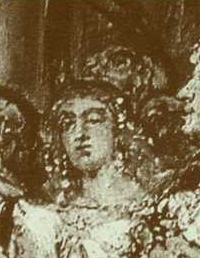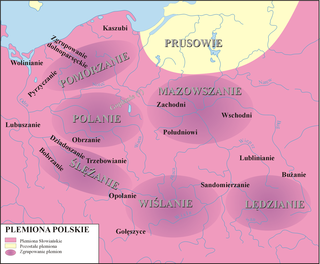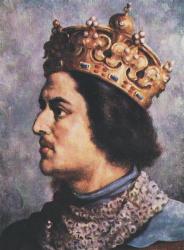Mieszko I was the ruler of Poland from about 960 to his death and was the founder of the first independent Polish state, the Duchy of Poland. He was a member of the Piast dynasty, a son of Siemomysł and a grandson of Lestek. He was the father of Bolesław I the Brave and of Gunhild of Wenden. Most sources make Mieszko I the father of Sigrid the Haughty, a Scandinavian queen, the grandfather of Canute the Great and the great-grandfather of Gunhilda of Denmark, Canute the Great's daughter and wife of Henry III, Holy Roman Emperor.

Paweł Jasienica was the pen name of Leon Lech Beynar, a Polish historian, journalist, essayist and soldier.
Bolesław III Wrymouth, was the duke of Lesser Poland, Silesia and Sandomierz between 1102 and 1107 and over the whole of Poland between 1107 and 1138. He was the only child of Duke Władysław I Herman and his first wife, Judith of Bohemia.
The Peace of Bautzen was a treaty concluded on 30 January 1018, between Holy Roman Emperor Henry II and Bolesław I of Poland which ended a series of Polish-German wars over the control of Lusatia and Upper Lusatia as well as Bohemia, Moravia and Slovakia.

Cedynia is a small historic town in Poland, and the administrative seat of Gmina Cedynia in Gryfino County, West Pomeranian Voivodeship. It is situated close to the Oder river and the border with Germany. The town is known for the 972 Battle of Cedynia, the first historically recorded battle of Poland.
In the Battle of Cedynia or Zehden, an army of Mieszko I of Poland defeated forces of Hodo or Odo I of Lusatia on 24 June 972, near the Oder river. Whether or not the battle actually took place near the modern-day town of Cedynia is disputed in modern scholarship.

Sigrid the Haughty, also known as Sigrid Storråda (Swedish), is a queen appearing in Norse sagas. Sigrid appears in many late Icelandic sagas composed generations after the events they describe, but there is no reliable evidence correlating to her story as they describe her. She is sometimes listed as wife of Eric the Victorious of Sweden, then Sweyn Forkbeard of Denmark, while more contemporary sources such as Thietmar of Merseburg and Adam of Bremen instead claim that Sweyn was married to a Polish princess, identified as Świętosława. Snorri Sturluson gives conflicting information and in one place says that Sweyn was married to Sigrid and in another that he was married to a Gunhild of Wenden.
Zbigniew, was a duke of Poland during 1102–1107. He was the first-born son of Władysław I Herman and Przecława, possibly a member of the Prawdzic family.

Bezprym was the duke of Poland from 1031 until his death. He was the eldest son of King Bolesław the Brave, but was deprived of the succession by his father, who around 1001 sent him to Italy in order to become a monk at one of Saint Romuald's hermitages in Ravenna.
Świętosława is the name some historians have assigned a Polish princess, the daughter of Mieszko I of Poland and sister of Bolesław I of Poland, who married two Scandinavian kings. According to German chroniclers, this princess, whose name is not given, was married first to Eric the Victorious of Sweden and then to Sweyn Forkbeard of Denmark, giving the former a son, Olof, and the latter two sons, Harald and Cnut. Because a documented sister of Cnut seems to have borne the Polish name Świętosława, it has been speculated that this may also have been the name of their mother, the Polish princess of the chroniclers.

Leszek of Masovia was a Polish prince from the Piast dynasty, the Duke of Masovia from 1173 until his death. He was the only son of Bolesław IV the Curly, Duke of Masovia and High Prince of Poland, to survive his father. After his father's death he inherited Masovia. At the beginning, Leszek ruled under the guardianship of his uncle Casimir II the Just. He was a man of poor health. For a short time he supported his other uncle, Mieszko III the Old, but later decided to reconcile with Casimir II, who after Leszek's death inherited his duchy.

The Silesians were a tribe of West Slavs, specifically of the Lechitic/Polish group, inhabiting territories of Lower Silesia, near Ślęża mountain and Ślęza river, on both banks of the Oder, up to the area of modern city of Wrocław. They were the first permanent inhabitants of the site of Wrocław where they build a fort on Ostrów Tumski in the 9th century or earlier, which at the time was an island on the Oder.
Siemomysł, Siemosił, or Zemuzil was the first historically verifiable Duke of Pomerania, recorded in 1046 in the Annals of Niederaltaich.
Świętopełk Mieszkowic, was a Polish prince member of the House of Piast.
Dobroniega Ludgarda of Poland was a Polish princess, Margravine of Lusatia by marriage to Theodoric I, Margrave of Lusatia.
The German–Polish War consisted of a series of struggles from 1002 to 1018 between the Ottonian king Henry II of Germany and the Polish Piast ruler Bolesław I the Brave. The locus of conflict was the control of Lusatia, Upper Lusatia, as well as Bohemia, Moravia and Slovakia. The fighting ended with the Peace of Bautzen in 1018, which left Lusatia and Upper Lusatia as a fief of Poland, and Bohemia became a duchy in the Holy Roman Empire.

The Treaty of Kępno was an agreement between the High Duke of Poland and Wielkopolska Przemysł II and the Duke of Pomerania Mestwin II signed on February 15, 1282, which transferred the suzerainty over Gdańsk Pomerania (Pomeralia) to Przemysł. As a result of the treaty Przemysł adopted the title dux Polonie et Pomeranie.
Dytryk (Theoderick) – factual or titular district Duke of Poland. Grandson of Mieszko I and his second wife Oda of Haldensleben.
The German–Polish War was a conflict fought between 1028 and 1031. It was fought by Holy Roman Empire lead by Conrad II, Duchy of Bohemia lead by Bretislav I, Kievan Rus' lead by Yaroslav the Wise and, from 1031, Kingdom of Hungary lead by Stephen I, against Kingdom of Poland lead by Mieszko II Lambert and, until 1031, Kingdom of Hungary lead by Stephen I. The war had begun with Polish attacks on Saxony within the Holy Roman Empire. Following that, the Empire, and Kivean Rus' had attacked Poland winning the war in 1031. Following the German victory, Mieszko II Lambert was forced to abdicate, losing the title of the King of Poland, and his country being reformed into Duchy of Poland with Bezprym as a duke.

Polish–Veletian War was a military conflict fought between 963 and 967, by the Duchy of Poland led by Mieszko I, with later aid of the Duchy of Bohemia against the Confederacy of the Veleti led by Wichmann the Younger, with later aid of Wolinians. The war consisted of 3 Veletian campaigns against Poland, the first two of which were won by Veleti, and the last one by Poland, ending the war and establishing Polish hegemony in the Farther Pomerania.









